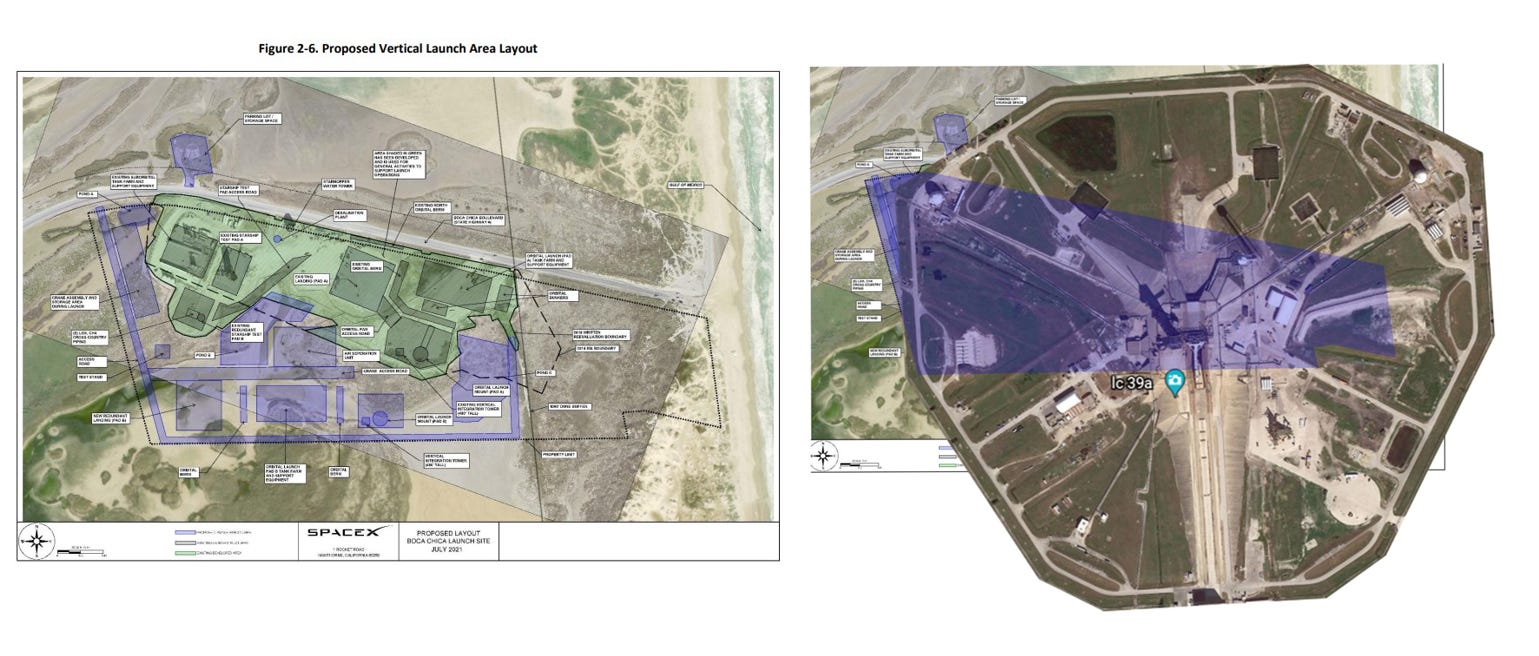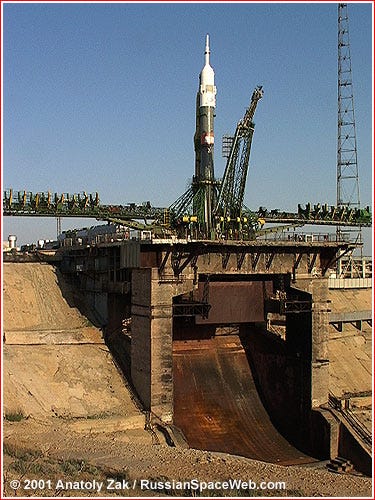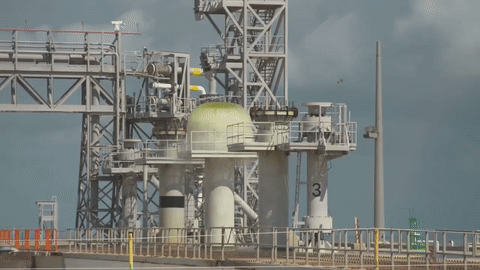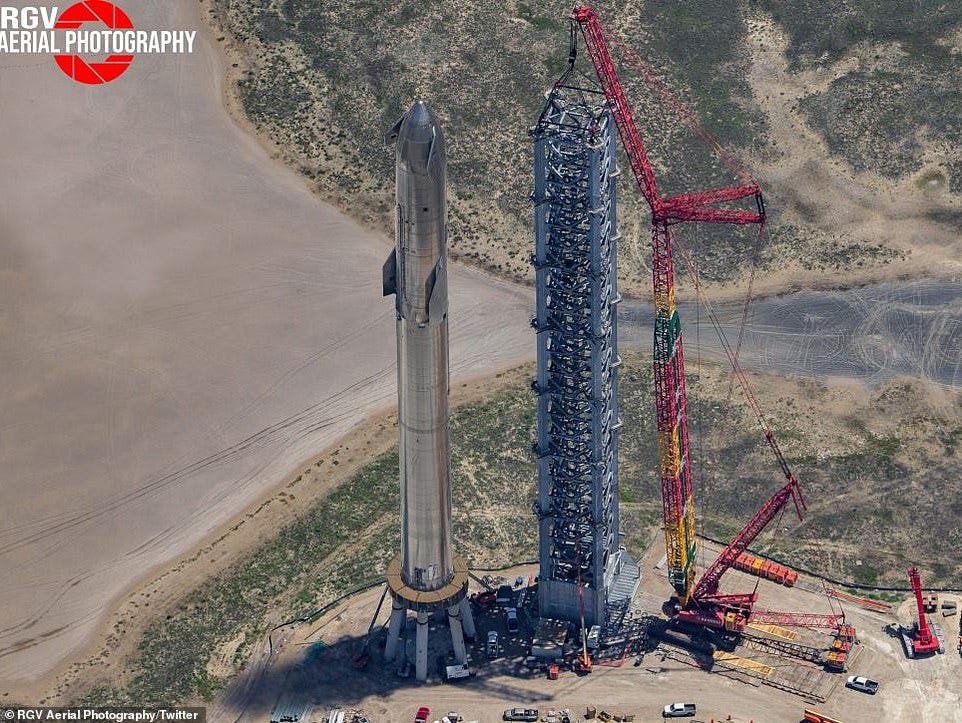On Friday, the Federal Aviation Administration issued a license for SpaceX to launch the first orbital test of Starship, the largest rocket in human history, as soon as this Monday, April 17th. I predict this will be a foolish and reckless decision, and impacts from even a nominal launch could prove catastrophic and significantly worse than presented to the public.
SpaceX and the FAA submitted extensive data as part of the NEPA environmental permitting process that started in September of 2020 to demonstrate the impacts launches and operations would have on the surrounding area.
In May of last year, I demonstrated that SpaceX used modeling data from early 2019 to seek approval for the launches; at that time in Starship’s development, the megarocket’s total thrust was estimated at 61.8 meganewtons (MN). Today, the rocket that sits on a pad in Boca Chica, Texas is rated at 74 MN, a 20% increase in size1.
This week, I received a Freedom of Information Act from the US Fish And Wildlife Service regarding information collected by US officials from the surrounding Lower Rio Grande Valley National Wildlife Refuge. An FWS employee measured a sound intensity reading of 110 decibels (dB) three miles from the launch site during a static fire test conducted in February.
This is a concerning development because the existing noise surveys indicate that the maximum reading that should have been detectable at this point is between 90-100. Decibels2 are a logarithmic scale (by tens), meaning that the FWS employee measured sound that is between 10x and 100x more powerful than what was predicted by SpaceX’s models. I’ve diagramed it here:

Further compounding the issue is that the February static test fire of Starship Superheavy’s 33 engines was done at just 50% of total thrust. A full-throttle test would have produced a significantly larger noise impact.
The Noise Bomb
These noise surveys and other factors, such as sonic boom intensity and heat plume that provide the basis for FAA’s rushed approval for SpaceX’s launch facility are all based on the smaller 2019 design version of Starship. These inputs provide the basis for all impacts measured in the NEPA document, meaning that the resulting damage to the community and the environment predicted are certainly understated, inadequate, and inaccurate.
Nearby cities Port Isabel and South Padre Island are under 5 miles away from the launch site; by comparison, the nearest cities to NASA’s Cape Canaveral 39-A launch complex, one of the only other sites permitted to launch supersized rockets, are 15 miles away.
The same model inputs that were used to (inaccurately) determine sound impacts from a static fire test also predict the maximum sound intensity expected during the first orbital launch attempt, which may occur as soon as tomorrow:
I won’t extrapolate the rather large miss for the static fire model on a granular basis onto the existing launch model because sound attenuation is a complex field of study. Still, it wouldn’t take much imagination to visualize a scenario where the nearby cities of Port Isabel and South Padre Island are exposed to significantly more powerful sound levels than predicted by this model.
Indeed, in approving SpaceX’s launch operations last year, the FAA didn’t even consider property damage in inhabited areas from a normal launch as a potential outcome because “the Lmax values of 111 dB and 120 dB may be used as a very conservative threshold for potential risk of structural damage claims.3”
SpaceX and FAA refused to update their models when pressed by the FWS during a review of operations’ impact on endangered species in February of last year, when the Service pointed out that the company had drastically increased engine sizing, stating that these same models used for approval under the Endangered Species Act were adequate.
Going beyond shattered glass and damaged foundations of beachside homes situated on stilts over sandy loam, the other potential impacts from a miscalculated sonic blast from a launch loom large.
SpaceX’s Boca Chica facility sits amid one of the most unique natural habitats in the northern hemisphere. The area is home to countless endangered species and provides a wintering home to the piping plover and red knot. These two federally protected shorebird species use the productive but ecologically sensitive low tidal marsh to nest and forage. SpaceX operations have already drastically reduced populations that return to the same spot year after year, per a study completed by the Coastal Bend Bays & Estuaries Program.
The company narrowly received authorization to “take” (e.g., legal term for kill, maim or displace) birds residing in dozens of acres of surrounding habitat from the FWS under an Endangered Species Act review4. But this study was, again, predicated on 2019 models that are already showing to be inadequate and inaccurate. An expanded radius for the noise bomb to occur upon launch could kill hundreds of additional wildlife, to an extent neither predicted nor disclosed to the public.
Put into context, human hearing is nearly instantly and permanently damaged at 120 dB; your eardrums will rupture at 130 dB. Birds are likely even more sensitive to high sound exposure. Inaccurate sound models will necessarily lead to inaccurate harm predictions.
SpaceX’s Facility is Poorly Designed
SpaceX’s Starship Superheavy launch system is massive, generating nearly 10x the thrust of the company’s workhorse, the Falcon 9 rocket. The pad and launch complex at Boca Chica is almost laughably tiny. An overlay of the launch complex 39-A in Cape Canaveral used to launch other superheavy rockets (Saturn V, the SLS System) is quite revealing.

SpaceX convinced FAA to approve a site that would host launching the Largest Rocket in History under NEPA’s Environmental Assessment (EA) process, which is saved for projects that do not have a “significant impact” to the environment. This action was and is eyebrow-raising, as no major spaceport has ever been authorized under this process, always requiring a full Environmental Impact Statement (EIS). An EIS is the default multi-year approval process specified under NEPA. The FAA piggybacked on an existing 2015 authorization for SpaceX’s operation of 2-3 annual launches of the much smaller Falcon 9 rockets to forward this streamlined Starship “low impact” approval process through the system.
The 39-A NASA mega-rocket complex in Florida is nearly 4x the total acreage of SpaceX’s Texas site and was designed with sufficient separation from the launch tower to surrounding undeveloped land. NASA also owns and operates the thousands of acres surrounding these pads.
Here in Texas, SpaceX’s launch tower sits 500 feet away from the protected habitat owned by either the Fish And Wildlife Service or Texas Parks and Wildlife. All of the surrounding land, however, is considered protected wildlife habitat under the Endangered Species Act.
In addition to the siting and sizing of the pad, SpaceX does not have a flame trench, nor do they have a water deluge system used to suppress heat and sound energy from any launches, as the Army Corps of Engineering permitting required to add these civil engineering systems is itself a multi-year process.
No large rocket complex on the planet: not in Russia, nor China, and certainly not in the US, exists that doesn’t contain one or both of these energy suppression systems.
These mechanisms exist to protect the rocket itself and nearby support infrastructure. They also minimize shock waves and sound energy impacts on the surrounding environment. The fact that these protections are the default, and have been so for decades, even in countries with lesser environmental and safety regulations, is quite telling.

SpaceX’s orbital pad, by way of comparison, is but a 30 ft tall stand situated 400 feet away from Methane storage tanks and 500 feet away from ecologically sensitive low tidal flats.
The heat plume expected from launch would instantly kill any animal unfortunate enough to be caught in its wake. Though SpaceX did admit to this fact, several wildlife biologists I spoke with were stunned at some of the language used in FAA’s justification for minimizing modeled casualties. Lines such as: “Noise from the Raptor engines would cause a startle response of animals and would effectively direct them away from the area and reduce the risk of being affected by the heat of the plume5” appear to serve more as handwaving away actual impacts rather than discuss them in a serious manner.
SpaceX’s insistence on avoiding plume mitigation techniques like engineered flame trenches or water suppressions systems, especially given the site’s close proximity to refuge land not owned by the company, appears to not be a technical decision, but rather one of expediency. Musk, after all, did famously call the Boca Chica area “A Wasteland.” Why would we expect him to treat it any differently?
Ready for Launch?
The concerns I’ve highlighted above are not new to long-time readers. I’ve spent a lot of time covering this strange and twisting tale of government regulatory failure and acquiescence by the press and public to the idea that Musk, the richest man on the planet, gets what he wants, consequences be damned.
I expected more from our agencies, from the press, and frankly from SpaceX itself. I still am in shock that a rocket system, the largest in history, will be fired off, from an inadequate facility, in the middle of an endangered species habitat, by a company that revels in the beautiful failure of explosions with seemingly no guardrails and no respect for the real danger this operation presents to the public.
I could sit here and snipe at Mr. Musk; it wouldn't be the first time I’ve done so. But the real failure here sits with the FAA. The same agency that enabled Boeing to approve and deploy the critically flawed and deadly Boeing 737 Max appears to have learned nothing. They gaslighted advocates and critics from day one. They pulled every trick in the book: releasing legal documents on Fridays, ignoring requests for legally mandated bi-lingual outreach, compressing review schedules, and bullying other federal agencies into submission at the behest of Mr. Musk.
The damage from SpaceX’s incursion into South Texas’ pristine coast is already real. The harm from the full launches will undoubtedly be greater than what was disclosed to the public. These damages may show up as shattered windows and the corpses of hundreds of dead shorebirds; immediate and obvious. Or they may not be entirely clear until years from now when SpaceX eventually closes shop on the Texas coast for greener pastures. The scars on the land, the people, and the wildlife won’t just disappear. They’ll linger, and hopefully, by then people will be willing to listen to the story.
Can’t say you weren’t warned.
Note: This Work I’ve done on SpaceX is an act of love and self discovery; I’ve received zero compensation for it. If you like seeing content like this, please subscribe, hit the like button, or even better: send me an email. Thanks, Eric
Based on Data in the FAA Programmatic Environmental Assessment and Endangered Species Act Consultation
Decibels in this piece refer to dB(A), as that's the default for all regulatory purposes (OSHA and FAA). Meters for field use measure in this unit, which is weighted to match frequencies detected by the human ear.









Thank you for this. Thank you, thank you, thank you. I take my kids all the time to Brownsville. My kids go to field trips there all the time too.
Now I fear for their safety. I don't think the Cameron County government and the Texas State government can be trusted from now on. If either of my kids get injured, or even die, because of their dangerous and irresponsible tests, it will be difficult for me to seek justice for them. This greed over human lives mentality needs to stop.
I'll trust NASA, but SpaceX and Tesla have both proven that they're not trustworthy. Hell, most corporations prove they're not trustworthy on the daily.
Sad. We expect our government to simply enforce laws that are there for the benefit of all only to see them ignore the duty and the harm that will be caused. Super frustrating. Also frustrating that the average American would have no idea of the issues you just presented let alone care.